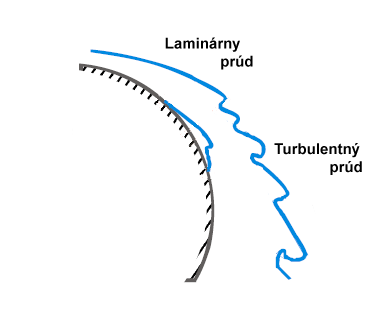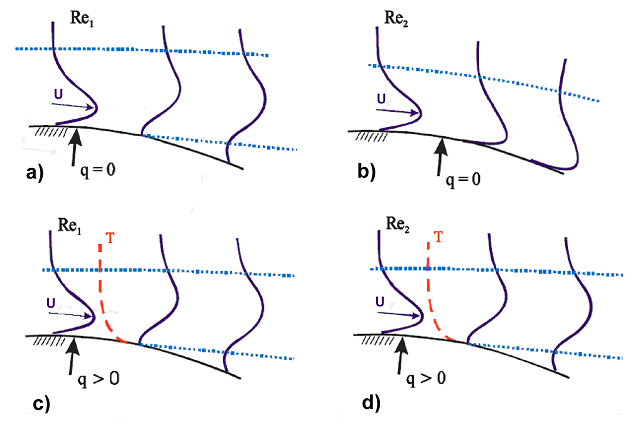Flow_along_a_Curved_Wall_with_Thermal_Gradient
3.4.3 Flow along a Curved Wall with Thermal Gradient
This part of the study deals with visualisation of the flow along the curved wall around a heated cylinder through holographic interferometry. Its goal was to investigate the free convection and the flow along the curved wall with present thermal gradient and Coanda effect.
The free (natural) convection is a sort of heat transmission by flowing that happens when the fluid is not forced to flow by any external intervention.
Typical is the heat transmission by convection between the flowing fluid and a boundary surface if they have different temperatures. Near the surface a layer of a fluid is formed within which the flow velocity changes from the value of 0 up to the so-called free-flow velocity. This layer is called the hydrodynamic boundary layer. Similarly, the thermal boundary layer is created.
During the convective heat transmission two mechanisms are employed. The first mechanism (diffusion) is dominant close to the surface, where the fluid flow velocity is low (on the surface it decreases to zero). The second mechanism (volume flow rate) is employed to cause the event where the fluid is separated from the free flow to the boundary layer. These mechanisms, diffusion and volume flow rate (advection) are connected with the transmission of the internal energy of the substance.
During the flow across lateral boundaries of the cylinder in a certain distance, the boundary layer separates. Localization of the separation place is important because as the flow approaches this place the heat transmission decreases. Then local overheating of the given surface and its strong thermal stress can occur.
During the circumfluence of the surface the situations can occur when either laminar, turbulent or both modes are formed on the surface. A laminar boundary layer is usually the first to be created on the circumfluenced surface. In a certain distance it changes into turbulent mode. This is schematically displayed in Fig. 3–67. First the laminar boundary layer is developed and after a certain distance the streamlines start to deform and gradually create closed whirls of various sizes.

The character of the velocity as well as temperature and concentration profiles is in laminar and turbulent boundary layer different.
The course of heat transfer coefficient is qualitatively equal in both modes. Always with gradual development of the boundary layer, with the increase of its thickness the coefficient decreases. After transition into the turbulent boundary layer a steep increase of heat transfer coefficient appears. This is caused by the origin of an additional transmission mechanism – the turbulence, i.e. by movement of whirls that force the heat transmission from the surface towards the flow direction. This mechanism is similar to the diffusive mechanism with random molecule movements. Therefore, we sometimes call it the turbulent diffusion (Jícha, 1986).
From everyday life, the phenomenon is well-known, where we can observe a strong tendency of the fluid flow to attache to the surface in its close surrounding. When we observe a free flow of a fluid we can see the fluid attachement to the flow boundary. When the flow reaches a wall neighbourhood, its velocity will increase in the area between its core and the wall. The velocity increase is accompanied by pressure decrease near the wall. The pressure on the wall will finally be lower than the pressure in the surrounding, which will result in attachement of the fluid flow to the circumfluenced wall. This phenomenon is called Coanda effect. In dependence on the flow parameters and the shape of the circumfluenced surface the flow either remains attached to the wall or is separated from it.
In the case of the flow along the curved wall at a certain value of Reynolds number the transition of the convection from laminar into turbulent form happens. For the flow along the curved wall, this transition is very well observable thanks to the laminar flow tendency to separate from the circumfluenced surface. The turbulent flow has a strong tendency to remain attached to the circumfluenced surface. Besides the geometric configuration of the flowing medium and its material characteristics there are other factors influencing the flow character such as roughness and temperature of the circumfluenced surface.
The change of the circumfluenced object temperature can have an important influence on the character of the flow along a curved wall. The temperature increase has several effects: the kinematic viscosity of the flowing medium will change and, thereby, the value of Reynolds number, the heating of the circumfluenced wall will lead (if the air circulation velocity is low) to stabilization of the boundary layer and thus to postponing of the transition into the turbulence (Fig. 3–68); the heating leads to creation of the buoyancy force that can influence the results.

a), c), d) separated flow, b) attached flow
At the flow along a curved wall the laminar flow tends to separate while the turbulent flow is accompanied by strong attachement of the flow, i.e. by so-called Coanda effect (Vít, 2004).


